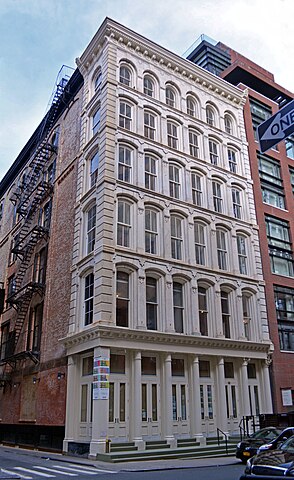
Robert Gober is an American sculptor. His work is often related to domestic and familiar objects such as sinks, doors, and legs.
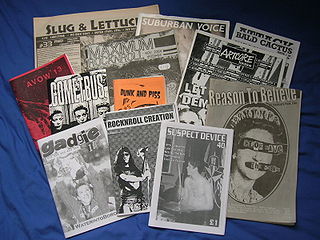
Punk visual art is artwork associated with the punk subculture and the No wave movement. It is prevalent in punk rock album covers, flyers for punk concerts and punk zines, but has also been prolific in other mediums, such as the visual arts, the performing arts, literature and cinema. Punk manifested itself "differently but consistently" in different cultural spheres. Punk also led to the birth of several movements: new wave, no wave, dark wave, industrial, hardcore, queercore, etc., which are sometimes showcased in art galleries and exhibition spaces. The punk aesthetic was a dominant strand from 1982 to 1986 in the many art galleries of the East Village of Manhattan.
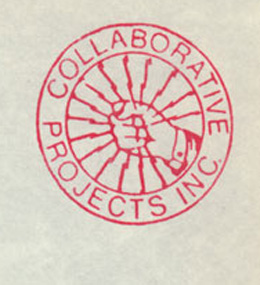
Colab is the commonly used abbreviation of the New York City artists' group Collaborative Projects, which was formed after a series of open meetings between artists of various disciplines.
Lance Fung Gallery (1996-2003) was an art gallery of contemporary art once located at 537 Broadway in New York City where it shared an exhibition space with the Emily Harvey Gallery.
Vincent Como is a Brooklyn-based visual artist. His work is rooted in Minimalism, Conceptual Art, and Color Field Painting with a specific focus toward Black. Como has referenced the influence of Ad Reinhardt and Kasimir Malevich, as well as movements such as the Italian Arte Povera movement from the 1960s.
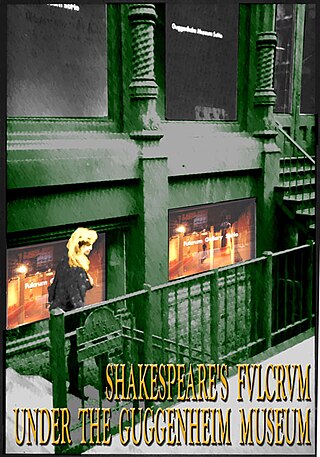
Fulcrum Gallery was an American art gallery that opened underneath the Guggenheim Museum SoHo in New York City in January 1993, by Valerie Monroe Shakespeare. It was designed by her husband, Tery Fugate-Wilcox, who contributed the gallery motto: "Without Art we are but Monkeys with Car Keys". Fugate-Wilcox is credited as photographer on all of the gallery's ads, and was listed as one of the nineteen artists represented by the gallery. The owner said in an interview, that the name "Fulcrum", came from Archimedes, "Give me a place to stand, a lever long enough and a fulcrum. and I can move the Earth". She said she hoped Fulcrum would become a "pivotal point in art history". Fulcrum Gallery was founded to exhibit Actual Art exclusively and did so until the effects of the attacks of 9/11 caused the gallery to close in February 2002.
Brian Christopher Rutenberg is an American abstract painter.
The Pictures Generation, 1974–1984 was an exhibition at The Metropolitan Museum of Art in New York City that ran from April 29 – August 2, 2009. The exhibition took its name from Pictures, a 1977 five person group show organized by art historian and critic Douglas Crimp (1944–2019) at New York City's Artists Space gallery. The artists exhibited from September 24 to October 29, 1977 were Troy Brauntuch, Jack Goldstein, Sherrie Levine, Robert Longo and Philip Smith.
Christopher D’Arcangelo was an American artist who worked in the 1970s until his death in 1979. He was the son of the American painter Allan D'Arcangelo.

Marlborough Fine Art was founded in London in 1946 by Frank Lloyd and Harry Fischer. In 1963, a gallery was opened as Marlborough-Gerson in Manhattan, New York, at the Fuller Building on Madison Avenue and 57th Street, which later relocated in 1971 to its present location, 40 West 57th Street. The gallery operates another New York space on West 25th Street, which opened in 2007. It briefly opened a Lower East Side space on Broome Street.
Claudia Gould is an art curator and former Helen Goldsmith Menschel Director of The Jewish Museum in New York City.

Catherine de Zegher is a Belgian curator and a modern and contemporary art historian. She has a degree in art history and archaeology from the University of Ghent.
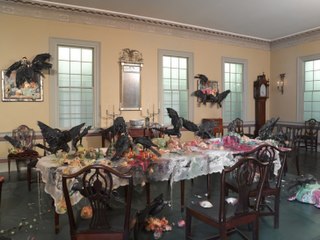
Valerie Hegarty is an American painter, sculptor, and installation artist. She is known for irreverent, often critical works that replicate canonical paintings, furnishings, and architectural spaces from American or personal history undergoing various processes of transformation. Hegarty most often portrays her recreations in meticulously realized, trompe l’oeil states of decay, ruin, or physical attack related to their circumstances. Her work examines American historical themes involving colonization, slavery, Manifest Destiny, nationalism, art-historical movements and their ideological tenets, romantic conceptions of nature, and environmental degradation. Sculpture critic Robin Reisenfeld wrote that among other things, Hegarty's art is "informed by 19th-century American landscape painting as an expression of the sublime, as well as by the manufacturing of two-dimensional 'masterworks' to be destroyed in three-dimensional fashion in order to evoke entropic forces of growth and decay."
Helene Winer is an American art gallery owner and curator. She co-owned Metro Pictures Gallery in New York City with Janelle Reiring. Metro Pictures closed in late 2021. Her career deeply involved the postmodern artists of the 1970s and 1980s known as the Pictures Generation. She lives in Tribeca.

Janet Henry is a visual artist based in New York City.
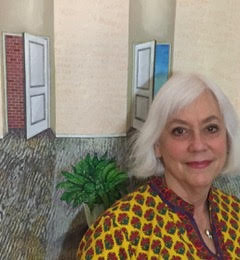
Robin Tewes is a Queens-born, New York City-based artist, known since the early 1980s for her representational paintings of frozen, narrative-like moments. She has shown her work in numerous solo exhibitions in New York City, as well as nationally and internationally, and exhibited at venues including P.S. 1, the Museum of Modern Art, the Whitney Museum, The Drawing Center, and the Central Academy of Fine Arts (Beijing), among many. Her work has been widely discussed in publications including Artforum, Art in America, ARTnews, Tema Celeste, the New York Times, the Los Angeles Times, and the Village Voice. Tewes was a founding member of the P.S. 122 Painting Association. She has been recognized with a Pollock-Krasner Foundation Fellowship (2015) and Painting Award (2008), an Adolph and Esther Gottlieb Foundation Award (2007), and inclusion in the Smithsonian Archives of American Art in 2016.

Cameron Rowland is an American conceptual artist whose work has been exhibited internationally and acclaimed for its structural analytic approach to addressing issues of American slavery, mass incarceration, and reparations. Rowland graduated from Wesleyan University in 2011 and they were awarded the MacArthur Fellowship in 2019 after several solo and group exhibitions at venues including the Museum of Modern Art, Whitney Museum of American Art, Kunsthal Aarhus, and La Biennale de Montreal. Rowland is noted for their distinct method of loaning some works to collectors and institutions rather than selling them outright, an approach meant to mirror the experience of low-income people shopping at rent-to-own stores like Rent-A-Center and disrupt the traditional value structure in the contemporary art market.
Four Walls was an artist collaborative event space. From 1984 to 2000, it hosted a wide range of one night activities, such as artist conversations, panel discussions, exhibitions, screenings and performances. The organization consisted of two consecutive phases from 1984 to 1988 in Hoboken, New Jersey and from 1991 to 2000 in the Greenpoint Williamsburg neighborhood of Brooklyn, New York. Throughout its life Four Walls was situated in growing creative communities where it served to encourage an exchange of ideas and generated alternative ways of experiencing art.
Daniel S. Palmer is an American curator and art historian. Palmer is currently Chief Curator at the SCAD Museum of Art. He was previously the Curator at Public Art Fund, New York, where he organized 18 exhibitions from 2016 to 2022. Before that, he held the position of the Leon Levy Assistant Curator at the Jewish Museum, New York and was a curatorial research assistant at the Whitney Museum of American Art. He received his PhD in Art History from the CUNY Graduate Center in 2021. He also holds a M.Phil in Art History from the CUNY Graduate Center and a BA from Rutgers University.

The Cinque Gallery (1969–2004) was co-founded by artists Romare Bearden, Ernest Crichlow, and Norman Lewis as an outgrowth of the Black power movement to "provide a place where the works of unknown, and neglected artists of talent …" — primarily Black artists — "would not only be shown but nurtured and developed". "Relying on a series of volunteers, Cinque hosted solo, group, and touring exhibitions," and sponsored an artist-in-residence program, which was inaugurated with collagist Nanette Carter.
